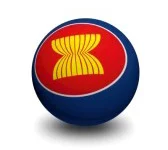This year, Asean turns 50. If Asean were a person, it would be due for a mid-life crisis. From inception to expansion, Asean has evolved considerably. Over the years, the Asean way of soft, flexible diplomacy, a preference for principles and non-intervention in neighbouring states’ affairs slowly made way for increasing institutionalisation, legalism and a reinterpretation of non-intervention. The formalisation of the Asean Charter, the establishment of the Asean Intergovernmental Commission on Human Rights and the launch of the Asean Community, for example, would have been unthinkable 50 years ago when relations were tense between the Asean founding members. None are end goals and all are imperfect, yet they represent progress.
Asean’s biggest achievement, so far, has been to prevent a conflict from breaking out in the region. But, success is hard to prove based on a counterfactual and Asean has struggled with the region’s below-the-threshold challenges. Both the grouping’s supporters and sceptics will want to see more from Asean if it is to live up to its ambition of being people-oriented and people-centred and if it is to be effectual in managing power jostles in this region.
There have been some positive developments on politically charged issues. The Asean Foreign Ministers’ retreat on violence in Rakhine State convened by Myanmar’s state counsellor in Yangon before the December holiday season was encouraging.
Ministers reported on a frank exchange of views and proposals were made to alleviate the long-standing, dire humanitarian situation of the Rohingya community. But, no concrete next steps have emerged and the region wonders if pressures have only temporarily abated before the next wave of irregular migration spills across borders.
Tensions have also cooled in the South China Sea following the Philippines’s improved relationship with China under President Rodrigo Duterte. Much has been made of this turn in tide and what it means for the South China Sea dispute.
The reality is that the Philippines is simply doing what many other Southeast Asian states have been doing all along — balancing between powers and hedging bets. This is the Philippines’s version of the rebalance; its pivot away from over-reliance on the United States towards a more independent foreign policy.
The other point to note is that the South China Sea is not about just the Philippines and China. It is also about three other Southeast Asian claimants and the awkwardly placed Taiwan. The dispute is a multilateral one to be managed and resolved multilaterally. It is one of the reasons a binding Code of Conduct (CoC) is being negotiated with China under the Asean rubric even though only four Asean member states are direct parties to the dispute. There are expectations that a framework agreement for the CoC will be concluded this year, in time for Asean’s 50th birthday. This is a constructive step.
To be clear, though, the framework agreement will be the placeholder for an eventual CoC, not the CoC itself and it will have been 15 years since the Declaration on the Conduct of Parties in the South China Sea (DoC) was signed for this interim arrangement to be arrived at.
In the meantime, satellite images show that the disputed seascape has drastically changed and claimants continue to change it in total disregard of principles outlined in the DoC. China’s speed and scale of its artificial island-building may be unparallelled but reclamation work by Vietnam and Taiwan has no less offended the DoC principle of “self-restraint in the conduct of activities that would complicate or escalate disputes and affect peace and stability”. It begs the question of why other claimants should continue to refrain from reclaiming the features they occupy.
Communal violence, irregular migration and the South China Sea dispute will continue to figure in Asean’s list of challenges this year. Radicalisation and violent extremism, as well as the now 20-yearold haze problem, will similarly demand attention. These issues are significant in and of themselves.
However, they are symptomatic of more fundamental challenges that Asean has been grappling with for a number of years now and will continue to do so in 2017. These revolve around questions of whether Asean can stay united when national and regional interests diverge, and whether 10 very diverse Asean member states can effectively manage relations with their richer, more powerful, and more influential neighbours each with their particular interests in the region.
This year, too, Asean faces a fair amount of uncertainty in one of its most important relationships in the region; that with the US. Southeast Asian observers have heard very little about the region and Asean from the incoming Trump administration beyond peripheral campaign and Twitter references to China’s activities in the South China Sea.
Consequently, there has been little clarity about what to expect of US policy towards Southeast Asia, its commitment to multilateralism in the region, and its placement of Asean in that framework. That may change in the next 10 days before president-elect Trump takes office or it may not.
What is clear, however, is that Asean will — as it has in the past — continue to work with all its dialogue partners regardless of where it falls on the priority list of others. The intricate web of issues Asean manages and their cross-border implications will command transactional cooperation, at the very least.
But, as the pieces move once again across the geopolitical board in this region, Asean will have to confront some difficult questions about itself and its place in the larger power play.
There is no doubt Asean has come a long way.
But, it is no longer 1967 and for Asean to be taken seriously, by its member states’ own citizens and by others, it will have to evolve, perhaps even structurally and procedurally, at a much faster pace than it is used to. In the meantime, Asean simply cannot afford any crises, mid-life or otherwise.
Article by Elina Noor which appeared in New Straits Times, January 10, 2017.





